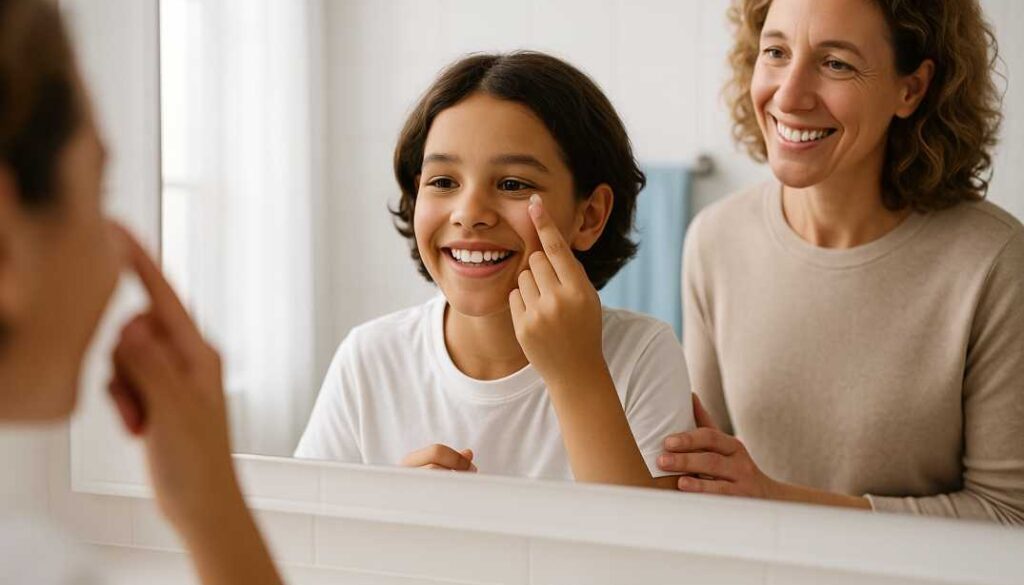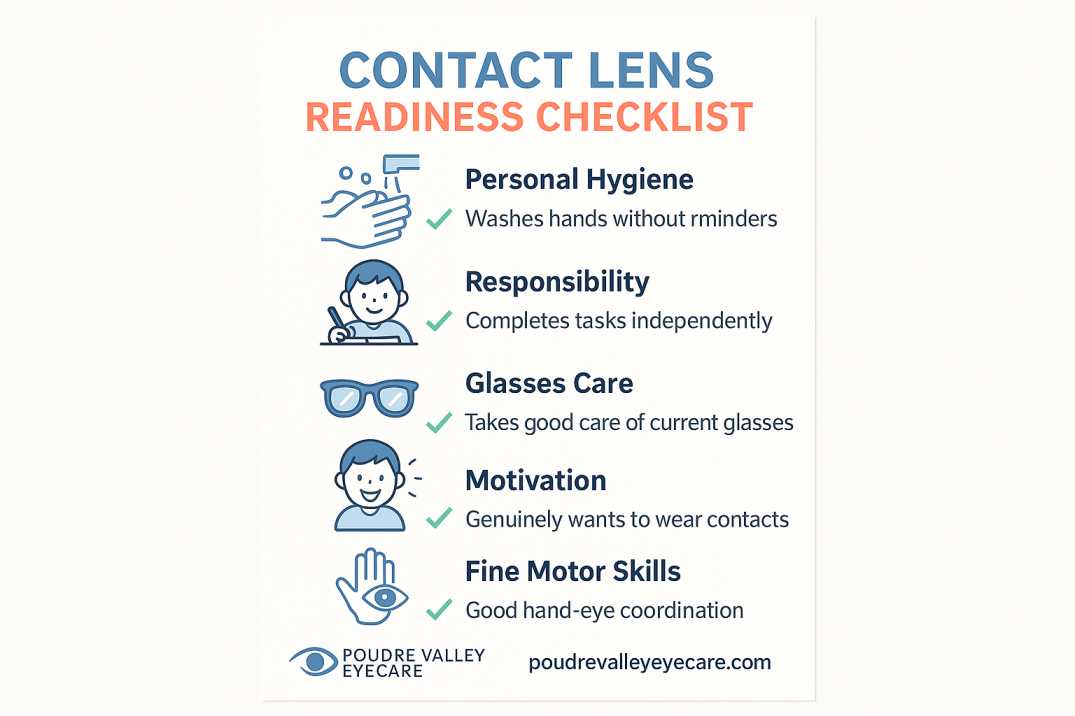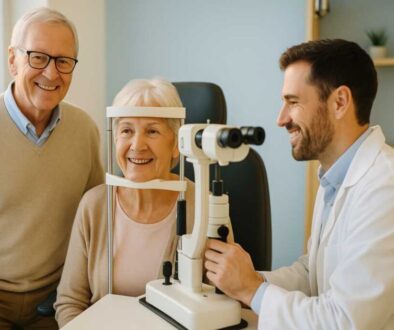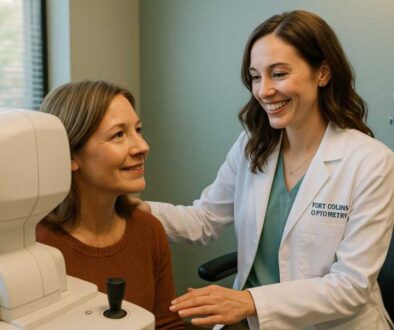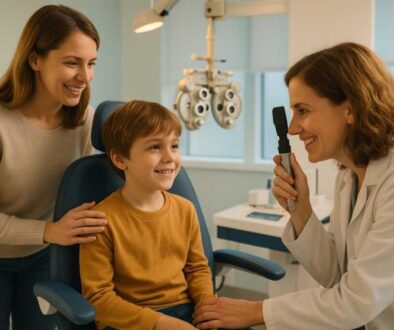Contact Lenses for Kids: When Are They Ready? | Guide
Quick Answer: Children as young as 8 years old can successfully wear contact lenses when they demonstrate proper maturity, hygiene habits, and responsibility. Age matters less than readiness—some 10-year-olds excel with contacts, while some teenagers aren’t ready. This guide helps you determine if your child is prepared for this important step in vision care.
If your child has been asking about ditching their glasses for contact lenses, you’re not alone. Many parents find themselves wondering whether their child is ready to make this important transition in vision care. At Poudre Valley Eyecare, we’ve been partnering with Fort Collins families for over 25 years, helping parents navigate these important decisions with confidence and clarity.
The good news? Children as young as eight years old can successfully wear contact lenses—but age is only part of the equation. Understanding when your child is truly ready involves looking at maturity, responsibility, and specific vision needs. This comprehensive guide will walk you through everything you need to know to make an informed decision for your family.
Understanding Contact Lenses for Kids: It’s More Than Just Age
While there’s no strict minimum age requirement for children to wear contact lenses, most kids begin wearing them between the ages of 8 and 12. Research shows that children as young as 8 years old demonstrate the same ability as teenagers to wear and care for contact lenses.
What matters more than your child’s birthday is their level of maturity and willingness to take on the responsibility that comes with contact lens wear. Think of it this way: if your child can consistently handle their daily routines without constant reminders, they might be ready for this next step in managing their eye health.
The Real Question: Maturity Over Age
Some children as young as six are ready for the responsibility, while some 16-year-olds are not. We work with each family to evaluate readiness based on individual circumstances rather than a one-size-fits-all age requirement.
Is Your Child Ready? Key Signs to Watch For
Deciding on contact lenses starts with an honest assessment. Here are the key indicators that suggest your child might be ready:
Deciding on contact lenses starts with an honest assessment. Here are the key indicators that suggest your child might be ready:
Responsibility and Personal Hygiene Habits
Children who need frequent reminders about handwashing, teeth brushing, or nail trimming may not be ready for contact lenses. Ask yourself:
- Does your child brush their teeth without being asked?
- Do they wash their hands regularly and thoroughly?
- Can they complete homework and chores independently?
- Do they get ready for school without constant supervision?
These daily habits are strong predictors of how well your child will manage contact lens care.
How They Care for Their Glasses
Frequently losing or breaking glasses can signal that a child isn’t quite mature enough for contact lenses. If your child treats their current eyewear with care, that’s an excellent sign they’ll be responsible with contacts.
Motivation and Interest Level
When a child asks for contact lenses and shows eagerness to try them, this demonstrates a good sense of responsibility and ownership. Genuine interest often translates to better compliance with care routines and wearing schedules.
Fine Motor Skills and Hand-Eye Coordination
Inserting, removing, and cleaning contact lenses requires good hand-eye coordination and patience during the learning process. Most children develop these skills naturally by age 8-10, but some younger children may also be capable.
Consistent Glasses Wearing
If your child only wears glasses for certain tasks at varying times, this would make contact lens wearing difficult. Contact lenses work best for children who need vision correction throughout their day.
The Amazing Benefits of Contact Lenses for Children
When children are ready, contact lenses can offer remarkable advantages that extend well beyond clear vision:
When children are ready, contact lenses can offer remarkable advantages that extend well beyond clear vision:
Boosting Self-Confidence and Social Well-being
Research involving 169 children found that contact lens wear significantly improves how kids feel about their appearance and participation in activities, with over 71% of children ages 8-12 preferring contacts to glasses. For many children, especially those with stronger prescriptions requiring thicker lenses, this confidence boost can positively impact school performance and friendships.
Superior Sports and Activity Performance
Contact lenses eliminate concerns about:
- Glasses breaking during contact sports
- Frames are slipping due to sweat
- Lenses fogging up during competition
- Limited peripheral vision affects performance
Contact lenses provide an unobstructed view of the playing field for better peripheral vision, enabling children to react faster to other players and objects.
Myopia Control: Protecting Your Child’s Future Vision
This is where contact lenses become more than just vision correction—they become proactive eye health care.
Recent NIH-funded research demonstrates that specialized multifocal contact lenses can slow myopia progression in children, with benefits continuing even after treatment ends. MiSight 1-day contact lenses are the first and only FDA-approved lenses proven to slow myopia progression in children aged 8-12 at treatment initiation.
Why does myopia control matter? Controlling myopia progression in childhood can help decrease risks of vision-threatening complications later in life, including retinal detachment, glaucoma, and cataracts. Starting treatment earlier and continuing through the late teenage years appears to offer the greatest benefit.
Better Vision Quality
In some cases, contact lenses can provide better quality of vision than eyeglasses, especially for very nearsighted children. The lenses move with your child’s eyes, providing more natural, consistent vision throughout their field of view.
Safety First: Understanding Risks and How to Avoid Them
We want parents to feel confident, not anxious. Understanding the risks—and how to prevent them—is essential.
We want parents to feel confident, not anxious. Understanding the risks—and how to prevent them—is essential.
The Reality of Contact Lens Safety in Children
Research shows that the incidence of corneal infiltrative events in children is no higher than in adults, and in the youngest age range of 8-11 years, it may be markedly lower. A three-year study of 294 children ages 7-11 concluded that contact lens wear is just as safe for children as for adults, provided there is proper supervision.
Common Risks (And How to Prevent Them)
Problems from contact lenses include eye infections and abrasions, with the most serious risk being corneal ulcers—severe infections that, if not quickly treated, can result in permanent vision loss. However, these serious complications are rare when proper care protocols are followed.
Prevention is straightforward:
- Always wash and dry your hands before touching lenses or eyes
- Never sleep in lenses unless specifically prescribed for overnight wear
- Avoid water contact with lenses (no swimming, showering, or bathing while wearing)
- Follow the replacement schedule exactly as prescribed
- Remove lenses immediately if experiencing redness, pain, or irritation
- Use only recommended solutions for cleaning and storing
Eye care professionals generally do not recommend extended wear lenses for kids and teens because they can increase the incidence of corneal ulcers.
Daily Disposable Lenses: The Safest Choice for Children
Daily disposable lenses can reduce some of the risks associated with wearing lenses since a new pair is used each day. Children under 12 years old are most frequently prescribed daily disposable soft contact lenses to avoid contamination from insufficient disinfection.
Types of Contact Lenses Available for Children
Understanding your options helps you have informed conversations with your eye care provider:
Understanding your options helps you have informed conversations with your eye care provider:
Daily Disposable Contact Lenses
Best for: Most children, especially first-time wearers and those under 12
These single-use lenses are worn during the day and thrown away each evening. No cleaning, no storage solutions, no hassle. While they may cost more than reusable lenses, they offer the highest safety profile and greatest convenience—perfect for busy families.
Myopia Control Contact Lenses
Best for: Children with progressive nearsightedness, typically ages 8-12
Special types of soft contact lenses called dual-focus, extended-depth-of-focus, and multifocal have evidence for slowing myopia progression in children from ages 7 to 16. These lenses correct vision while simultaneously working to slow eye growth.
Monthly or Bi-Weekly Disposable Lenses
Best for: Responsible older children and teenagers
As children grow into their preteen and teenage years, those who show responsibility with personal care are often ready to transition to longer-wear lenses. These require daily cleaning and proper storage, but are more cost-effective over time.
Orthokeratology (Ortho-K) Lenses
Best for: Highly responsible children committed to a nightly routine
These special rigid lenses are worn during sleep to temporarily reshape the cornea, allowing clear vision during the day without any eyewear. Ortho-K lenses can be an option for children who demonstrate responsibility and want freedom from wearing correction during the day.
Rigid Gas Permeable (RGP) Lenses
Best for: Children with specific vision needs like astigmatism
These durable lenses provide excellent vision quality and have high oxygen permeability. They require an adjustment period but are ideal for certain prescriptions and eye conditions.
What the Latest Research Tells Us (2024-2025)
Recent scientific advances continue to validate contact lenses as both safe and beneficial for children:
Recent scientific advances continue to validate contact lenses as both safe and beneficial for children:
Study 1: Long-Term Safety Confirmed
A six-year international study of 144 children wearing daily disposable contact lenses found only three subjects discontinued due to ocular adverse events, with no serious contact lens-related adverse events reported. This demonstrates that children can successfully wear daily disposable lenses with minimal impact on eye health.
Source: Chamberlain P, et al. “Ocular health of children wearing daily disposable contact lenses over 6 years.” Contact Lens and Anterior Eye, 2021.
Read the full study →
Study 2: Lasting Benefits of Myopia Control
NIH-funded research published in January 2025 found that children who wore multifocal contact lenses to slow myopia progression maintained treatment benefits even after stopping lens wear as older teens. The study suggests fitting children with multifocal lenses at a younger age and continuing treatment until the late teenage years when myopia progression naturally slows.
Source: Berntsen DA, et al. “Axial Growth and Myopia Progression After Discontinuing Soft Multifocal Contact Lens Wear.” JAMA Ophthalmology, January 2025.
Read the NIH press release →
Study 3: Safety Profile in Real-World Conditions
A retrospective chart review of over 3,500 contact lens wearers showed 88% had no clinical events, with the risk of microbial keratitis at 7.4 per 10,000 years of wear, with neither case resulting in vision loss. This real-world data confirms the safety of contact lens wear in children when proper care is followed.
Source: Chalmers RL, et al. “The Contact Lens Assessment in Youth (CLAY) Study.” PMC/National Library of Medicine.
Access the research →
Getting Started: Your Step-by-Step Guide
Ready to explore contact lenses for your child? Here’s how to begin:
Ready to explore contact lenses for your child? Here’s how to begin:
Step 1: Schedule a Comprehensive Eye Exam and Contact Lens Fitting
Contact lens prescriptions differ from eyeglass prescriptions. A proper fitting ensures the lenses match your child’s unique eye shape and vision needs. At Poudre Valley Eyecare, we take the time to properly fit each child and provide thorough training.
Step 2: Have an Honest Conversation About Responsibilities
Discuss with your child:
- The importance of hand hygiene
- Never sharing lenses with friends
- Following the wearing schedules exactly
- Reportg any discomfort immediately
- The commitment to daily care (for reusable lenses)
Step 3: Practice Together
Practice inserting and removing lenses together until your child feels comfortable and confident, standing in front of a mirror and talking through each step. Most children master this within a few days to a week.
Step 4: Start Gradually
Begin with shorter wear times and gradually increase to 10 hours as per your doctor’s instructions. Weekend practice sessions allow more time for learning without the pressure of school schedules.
Step 5: Create a Routine
Make a checklist for inserting and removing lenses and place it on the mirror to establish a consistent routine. Consistency helps build good habits that will last a lifetime.
Special Considerations: When Contact Lenses May Not Be the Best Choice
While contact lenses work wonderfully for most children, there are situations where we might recommend waiting or pursuing alternative options:
While contact lenses work wonderfully for most children, there are situations where we might recommend waiting or pursuing alternative options:
Seasonal Allergies
Children with seasonal allergies are usually not good candidates for wearing contacts, as the lenses may increase the itching and burning caused by their allergies. Daily disposables can sometimes help, but we evaluate each case individually.
Certain Eye Conditions
Children with chronic dry eyes, recurring eye infections, or certain corneal conditions may need specialized lenses or alternative vision correction methods.
Lack of Consistent Vision Correction Needs
Children who only occasionally need vision correction might find contact lenses impractical compared to wearing glasses as needed.
Making the Decision: Working Together for Your Child’s Vision
Deciding whether your child is ready for contact lenses is a partnership between you, your child, and your eye care professional. At Poudre Valley Eyecare, we take the time to assess each child individually, considering not just their prescription, but their lifestyle, activities, and readiness for the responsibility.
Deciding whether your child is ready for contact lenses is a partnership between you, your child, and your eye care professional. At Poudre Valley Eyecare, we take the time to assess each child individually, considering not just their prescription, but their lifestyle, activities, and readiness for the responsibility.
Red Flags That Suggest Waiting
Consider postponing contact lenses if your child:
- Requires constant reminders about basic hygiene
- Frequently loses or damages their glasses
- Shows little interest in wearing contacts
- Struggles with following multi-step instructions
- Has difficulty touching near their eyes
Remember: There’s no rush. Waiting until your child demonstrates consistent responsibility ensures a positive experience when they do start wearing contacts.
Green Lights That Suggest Readiness
Your child may be ready if they:
- Independently manage personal hygiene
- Complete chores and homework without reminders
- Express a genuine interest in trying contact lenses
- Care for their glasses responsibly
- Can follow detailed instructions
- Participate in sports or activities where contact would help
The Poudre Valley Eyecare Difference
For over 25 years, we’ve been Fort Collins’ trusted partner in family eye health. Our approach to pediatric contact lens fittings combines:
For over 25 years, we’ve been Fort Collins’ trusted partner in family eye health. Our approach to pediatric contact lens fittings combines:
- Comprehensive evaluation of vision needs and lifestyle factors
- Patient, thorough training for both children and parents
- Ongoing support as your child grows and their needs change
- Access to the latest lens technologies, including myopia control options
- True accessibility through Medicare and Medicaid acceptance
We understand that every child develops at their own pace. Our experienced team works with families to find the perfect timing and lens type for each unique situation.
Resources & Scientific References
This article is supported by peer-reviewed research and authoritative medical sources. Below are key resources cited throughout this guide:
Primary Scientific Studies
- Berntsen DA, Ticak A, Orr DJ, et al. “Axial Growth and Myopia Progression After Discontinuing Soft Multifocal Contact Lens Wear.” JAMA Ophthalmology, January 2025.
📄 https://www.nih.gov/news-events/nih-research-matters/lasting-effects-contact-lenses-slow-myopia-kids
NIH-funded study demonstrating lasting myopia control benefits even after treatment discontinuation. - Chamberlain P, Bradley A, Arumugam B, et al. “Ocular health of children wearing daily disposable contact lenses over 6 years.” Contact Lens and Anterior Eye, February 2021.
📄 https://www.sciencedirect.com/science/article/pii/S1367048420302046
International multi-site study confirming long-term safety of daily disposable contact lenses in children ages 8-12 - Bullimore MA. “The Safety of Soft Contact Lenses in Children.” PMC/National Library of Medicine, June 2017.
📄 https://pmc.ncbi.nlm.nih.gov/articles/PMC5457812/
Comprehensive review demonstrating contact lens safety profile in children, including CLAY Study data from 3,500+ patients
Taking the Next Step: Your Child’s Vision Journey
Contact lenses can be transformative for children—boosting confidence, improving performance in activities they love, and in some cases, actively protecting their future eye health through myopia control. The key is ensuring your child is truly ready for the responsibility.
Contact lenses can be transformative for children—boosting confidence, improving performance in activities they love, and in some cases, actively protecting their future eye health through myopia control. The key is ensuring your child is truly ready for the responsibility.
If you’re considering contact lenses for your child, we invite you to schedule a consultation at Poudre Valley Eyecare. Together, we’ll evaluate your child’s vision needs, discuss their readiness, and create a personalized plan that sets them up for success.
Because at the end of the day, our goal isn’t just clear vision—it’s supporting the long-term eye health and confidence of every child who walks through our doors.
Ready to Explore Contact Lenses for Your Child?
Contact Poudre Valley Eyecare to schedule a comprehensive pediatric eye exam and contact lens consultation. Our Fort Collins office has been serving families like yours for over 25 years, combining expert care with the personal attention you deserve.
Your child’s clearer, more confident future starts with a conversation. Let’s have it together.
About the Author
Poudre Valley Eyecare Optometry Team
Serving Fort Collins Families Since 1999
Our experienced optometrists have been fitting children and teens with contact lenses for over 25 years, with specialized training in pediatric eye care and myopia management. We combine the latest contact lens technology with patient, family-centered care that puts your child’s comfort and success first.
Credentials & Expertise:
- 25+ years serving the Fort Collins community
- Specialized pediatric contact lens fitting
- Myopia control treatment certified
- Medicare and Medicaid providers
- Comprehensive family eye care
📍 Location: Fort Collins, Colorado
📞 Schedule a Consultation: [at Poudre Valley Eyecare]
FAQs
-
Children can start wearing contact lenses as early as age 8, though most optometrists recommend ages 10-12 as optimal for beginning contact lens wear.
Please note: None of the above should be considered medical advice. If you’re having any concerns about your vision, please reach out to us immediately or see your primary care provider.

